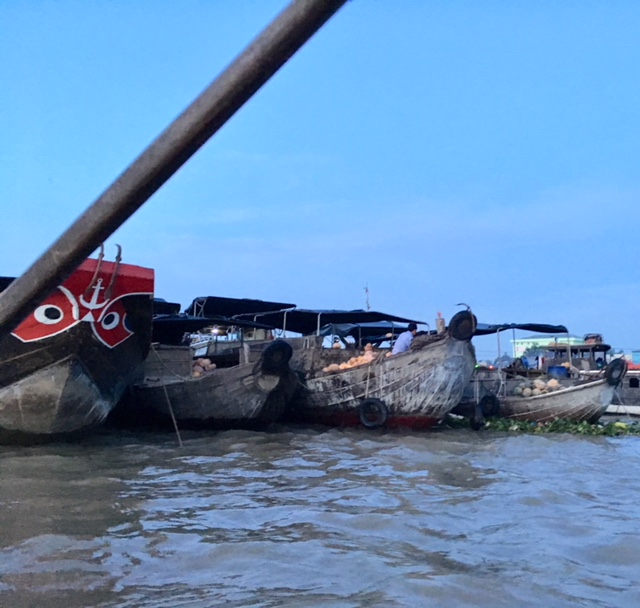
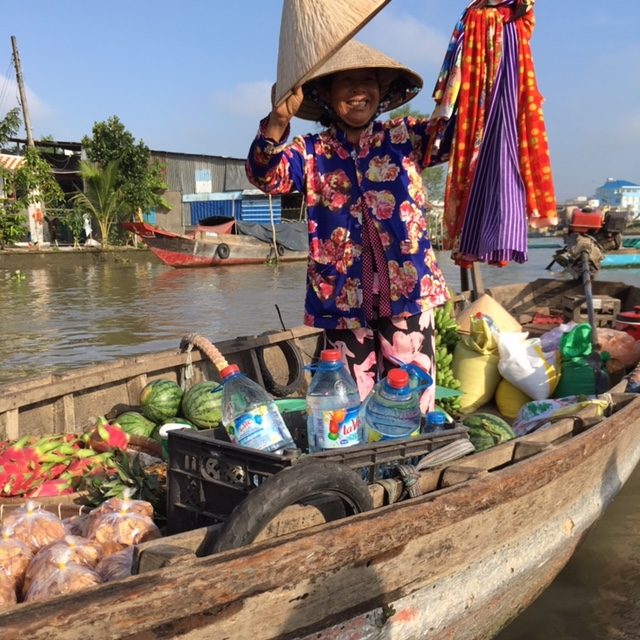
Danny, the young Vietnamese owner of the Balo Guesthouse in Can Tho, set me up with a tour of the floating markets in the delta just minutes after I arrived from the bus station. I was to be down in the loby at 4:50AM the next morning. Two other people had already booked and there was a four person max on this tour, so with me and the tour guide we were set. I settled into my room and then took off on foot to explore the neighborhood and find food before dark. Walking the streets of Can Tho I settled on Dao Hoa Dao – a seafood place on a back street where you pick what you want from aerated tanks, they pull it out with a net and take it to the grill guy up front who cooks it quickly over hot charcoal. I chose giant prawns, several of which popped out of the net before he could snatch them. Scrambling after them across the floor, he nabbed the fiesty fellows and asked me how many? I held up four fingers. Done deal. And delicous with garden lettuce and vegetables, a mountain of herbs, fresh lime jucie and salt. And a Saigon Special beer.
I went to bed early, woke up, showered and packed my little feather weight day pack with things I thought I might need for the day: hat, sun screen, Deet, shorts, flipflops, umbrella for sun or rain, money, phone/camera, and water. Since it was chilly on the water before the sun rose I wore long pants and a long sleeved white shirt and tennies. As usual the whole process of getting to the right boat with the right people in a huge, chaotic crowd and in the dark was a bit confusing but, as usual, it all worked out. When I actually caught myself, at Angkor Wat, worrying whether the sun would rise on time, I knew it was time to let it all go and just trust that, even though things aren’t done in the ways I’ m used to, they work here.
Johanna and Oscar, the Swiss couple from Geneva I was paired with, were the best company I could have hoped for. Our 23 year old guide (“call me Remy, my name is unpronounceable to you”) was super cute, very sweet, fluent in English and French, and turned out to be the greatest guide ever. The four of us talked non-stop for the 7 hour tour, discussing everything from communism to catfish, and I think we all learned a lot about Vietnam, Switzerland, the USA, and the similarities and differences in the way things are done in these three countries. I know I did.
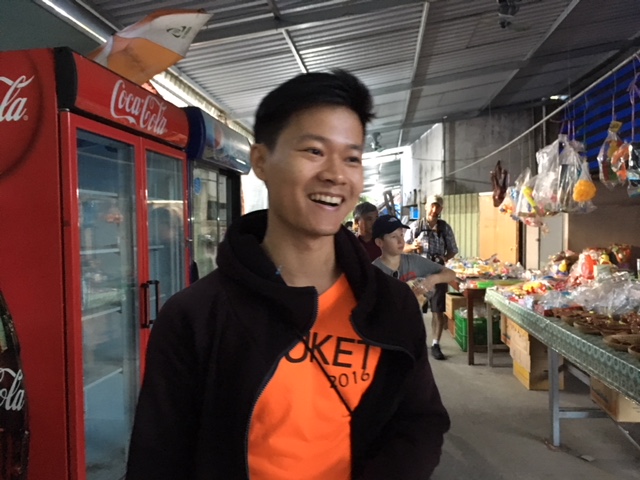
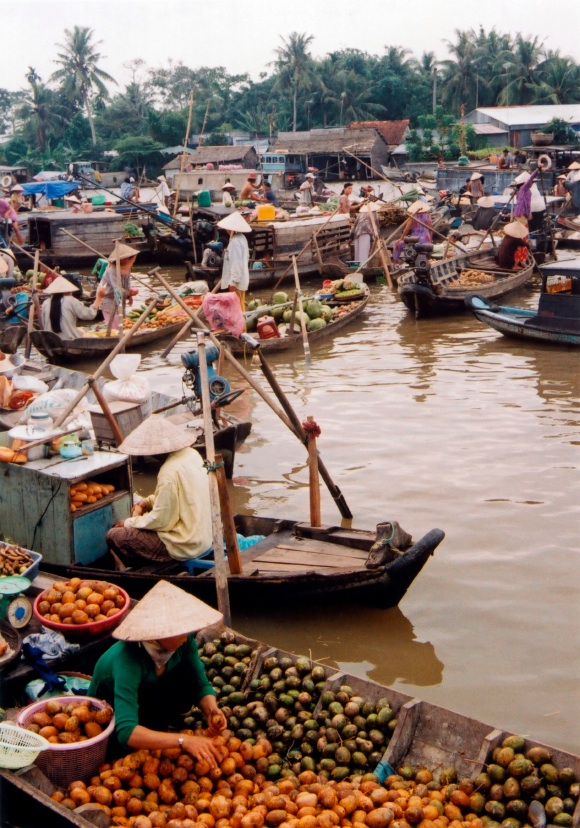
Our boatman motored us slowly up the wide Mekong (also known as the Nine Dragon River) in the dark, the large moon still hanging in the western sky and reflecting in a wide golden path on the surface of the river. Our goal was the floating market of Cai Rang, the largest in the delta. A swarm of other tourist boats of all sizes cruised in a huge school around us.
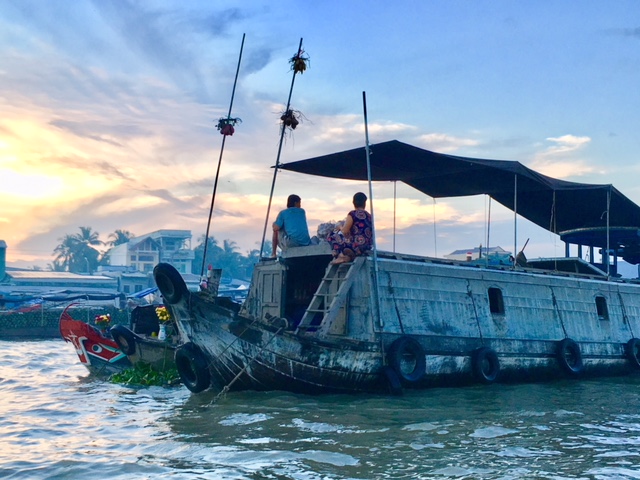
When we got to Cai Rang, straining our eyes to see, the sky began to lighten in the east. A dramatic sunrise, the sky full of mauve and apricot and gold, backlit the traditional wooden cargo boats – unpainted except for a bright red bow ornament with a pair of white and black rimmed eyes “to watch the path” and a painted anchor for a nose and mouth. Our boat was a long-tailed outboard. I’ve copied a bit of description from a site called boatsandrice.com which has detailed information of the boats of the Mekong. “In the small boats of Can Tho, the combination of two long oars worked across the body and a long-tailed outboard is the propulsion of choice.” Our boatman used the oars very skillfully in close quarters and turned on the 5 horse engine when we weren’t mobbed by other boats. In his spare time he wove decorative jewelry and ornaments out of coconut palms for us and handed us plates of local fruits and rice based treats for us to try. Remy had him stop at a banh mi boat for breakfast sandwiches and later, a coffee boat for cups of the local brew. Oscar and I like ours black and strong and hot, rather than the local favorite served with sweetened, condensed milk and ice. This was not a problem. Vietnam is the largest coffee exporter in the world and their coffee is so good! I kept thinking someone had put a splash of Kahlua in my cup or some other flavoring, but no, it’s just so rich and flavorful you think there must be more than just ground beans in there. Coffee (ca phe) is everywhere – from fancy western chains to zillions of tiny shops fronting the streets or a woman carrying coffee, ice and cups on the back of her bicycle – there’s no problem finding the good stuff when you’re in the mood. Draft beer (bia hoi) or bottled beer (bia) made in Vietnam, is likewise plentiful and delicious. Not as strong as what we’re used to, but a refreshing drink in this hot climate.
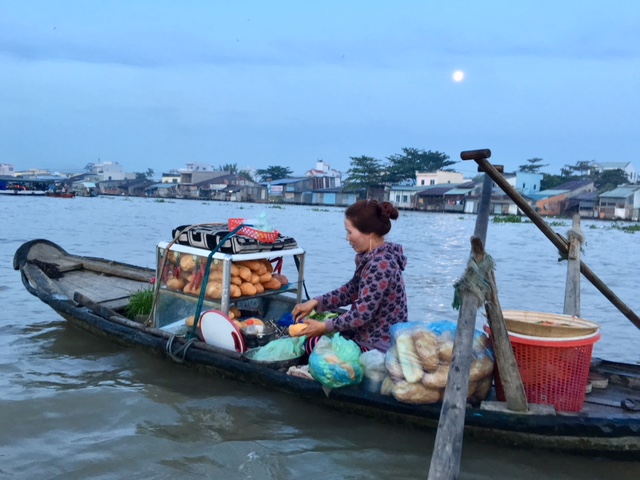
After cruising the picturesque market and taking picutres of the boats piled high with pineapples or watermelons or cabbages or mangoes and oranges, loaded with fish or wood or flowers or conical hats and scarves, we chugged into one of the thousands of small canals that weave through this enormous delta and stopped at a small settlement where rice noodles were being made. The southern part of Vietnam grows 2/3rds of the rice the country uses and exports, and the local “wet” market stalls sell an enviable selection of different kinds of rice as well as mountains of rice noodles. Who knew rice noodles were made by cooking huge rice crepes on steel disks heated with fires made from the chaff, drying them in the sun on bamboo racks for several days and then putting them through a machine that cuts them into the familiar noodle strips? I’ll never eat another rice noodle without appreciating what goes into them.
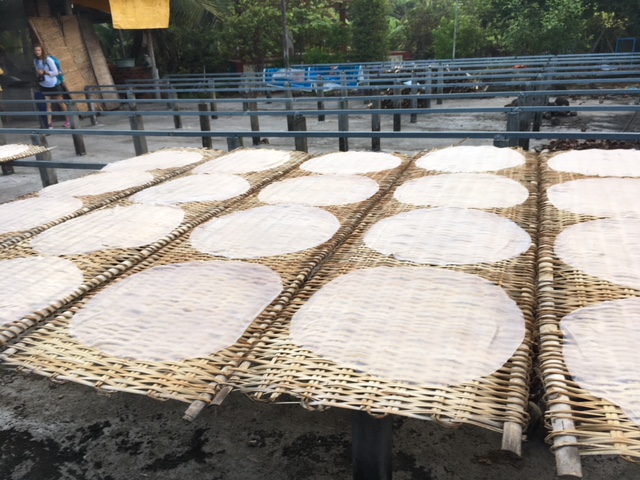
Later we toured a lush fruit farm irrigated by man made canals of Mekong water, and were introduced to the plants that grow dragon fruit and many other exotic fruits and flowers. The Mekong river starts in the mountains of Tibet and runs down to southern Vietnam where it empties into the South China Sea. The waters are brown with silt dragged from the land, making the soil extremely rich. Pollution is brought along with the soil, and hydroelectric damns are severely curtailing the natural runs of the fish that used to be so plentiful. Dozens more damns and coal plants are planned for the Mekong, many in northern Cambodia financed by the Chinese. All of this, combined with illegal fishing and climate change, are severely impacting the Mekong. The future of this great river and the people who have lived and worked on her fecund waters, is dim.
After a stop for a walk and a snack our boatman took us on to a smaller floating market. Passing islands of brilliant green, floating water hyacinths, ponds of lotus blossoms, thousands of ducks bobbing in the lee of the boats, the giant trees and vines forming a canopy above the jungle floor, I had nothing to relate this watery fairy tale landscape to except Disneyland. So beautiful and so surreal.
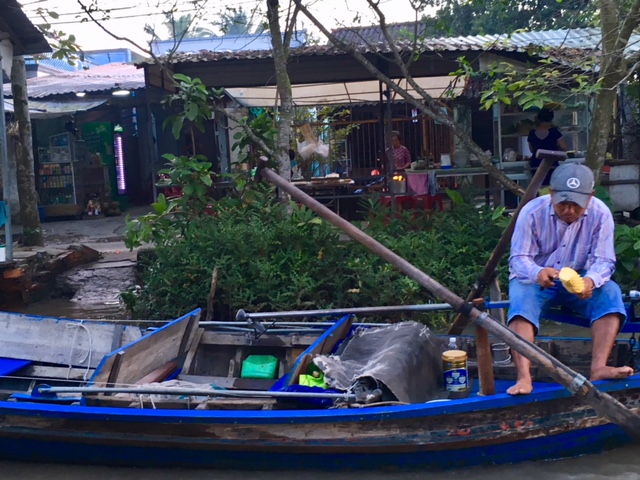
A few things I learned from Remy about Vietnam:
Taxes are very low. “The government does little for the people and “we pay for everything.”
There are pretty much no homeless people in Vietnam. Families take care of each other and communities and religious organizations take up the slack. According to Oscar’s reading there are more people in Switzerland living below the poverty line than there are in Vietnam. Of course the “poverty line,” as defined by each country, is hugely different. But still.
Electronics, like TVs and Mac products, are very expensive and can only be afforded by the rich. The average people buy Chinese phones and laptops and do without TVs. Remy watches mostly Korean and Japanese horror films, on his laptop. Netflix is an impossible luxury. (A TV I bought for $300. last year might go for $1500. here. Or more.) Western brand clothes – also very pricey. “We wear knock-offs. They look the same but aren’t.” Remy had on a pair of Air Jordan look-alike tennies that cost him less than $5.00.
Karaoke is the favorite “blow off smoke” activity in the country.
Yes, the paper masks many people wear are because of pollution, but also because no young person wants to have dark skin. “White is good, brown is bad,” Remy said. Heads, faces and bodies are covered top to bottom, no matter how hot the weather is. Plastic surgery to have a bridge added to the nose and eyes sliced at the outside edges to enlarge and westernize the orbs, is extremely common. Remy’s parents had the bridge of his nose raised and his nose straightened when he was very young. When I told him that, as a teenager, I had wished for straight, black hair, he was truly shocked. “WHY????” Skin products containing bleach and strong, chemical bleaching treatments are common. It’s the norm to see young women’s hair bleached. The beautiful shiny coal black, straight Asian hair is a thing of the past. Johanna says, “We all want what we don’t have.” We look at each other sadly, knowing the cost of being rich westerners and fearing for our Asian friends.
When young people marry, it is still the custom for the bride to quit school or her job and move in with her inlaws and take over caring for that entire family. Remy and his girlfriend are struggling with the choice of following this ancient Chinese and Vietnamese custom or leaving home and being cut off from both families. Their choice for now is to stay single.
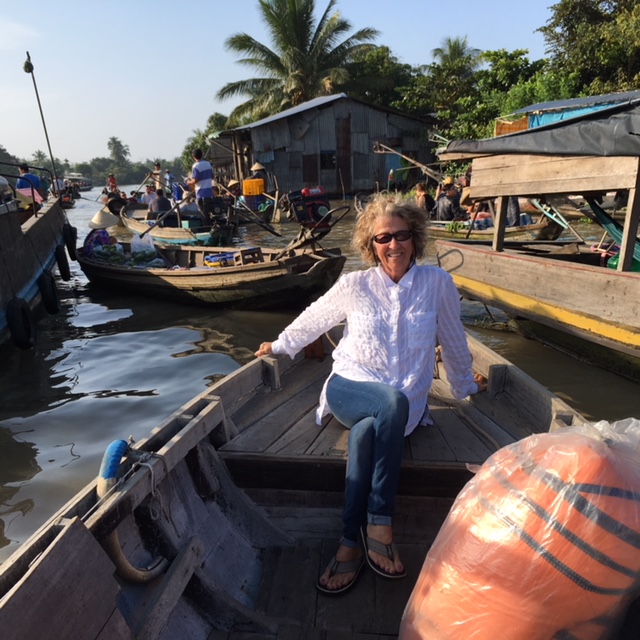
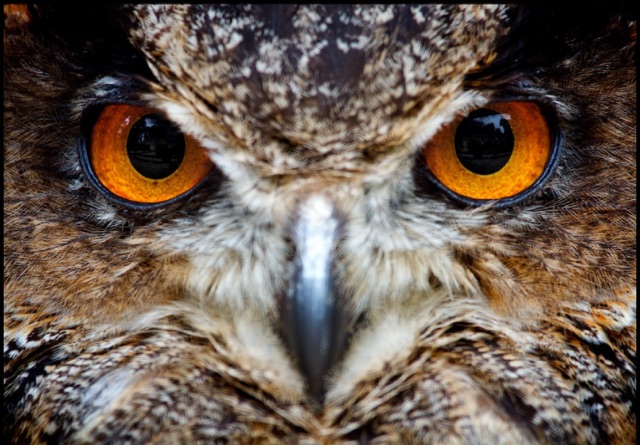
00ziuj
v7hw6u
11ikzp
knjdje
jeja3x
sxpuob
6j72d7
x0kmf8
xxaffm
38mb6t
97wkif
pb747t
ita3ht